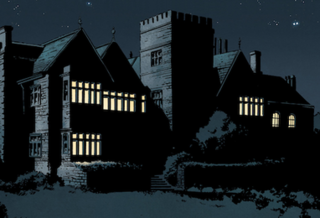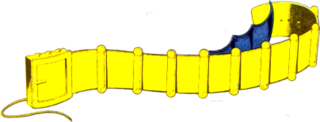
Batman is an American live-action television series based on the DC Comics character of the same name. It stars Adam West as Bruce Wayne/Batman and Burt Ward as Dick Grayson/Robin—two crime-fighting heroes who defend Gotham City from a variety of archvillains. It is known for its camp style and upbeat theme music, as well as its intentionally humorous, simplistic morality aimed at its preteen audience. It was described by executive producer William Dozier at the time as "the only situation comedy on the air without a laugh track". The 120 episodes aired on the ABC network for three seasons from January 12, 1966, to March 14, 1968, twice weekly during the first two seasons, and weekly for the third. In 2016, television critics Alan Sepinwall and Matt Zoller Seitz ranked Batman as the 82nd greatest American television series of all time. A companion feature film was released in 1966 between the first and second seasons of the TV show.

The Batcave is a subterranean location appearing in American comic books published by DC Comics. It is the headquarters of the superhero Batman, whose secret identity is Bruce Wayne and his partners, consisting of caves beneath his personal residence, Wayne Manor.

The Batmobile is the car driven by the superhero Batman. Housed in the Batcave, which it accesses through a hidden entrance, the Batmobile is both a heavily armored tactical assault vehicle and a personalized custom-built pursuit and capture vehicle that is used by Batman in his fight against crime. Using the latest civilian performance technology, coupled with prototype military-grade hardware—most of which was developed by Wayne Enterprises—Batman creates an imposing hybrid monster car to prowl the streets of Gotham City.

Wayne Manor is a fictional mansion appearing in American comic books published by DC Comics. It is the home of Bruce Wayne, owner of Wayne Enterprises, who is also the superhero Batman.

Lucius Fox is a character appearing in American comic books published by DC Comics, commonly in association with the superhero Bruce Wayne / Batman. He is Wayne's business manager at Wayne Enterprises who runs the business interests that supply his equipment needs as well as financing his operations, and is the father of Luke Fox / Batwing, Tiffany Fox / Batgirl, and Jace Fox / Batman.

Batman's utility belt is a feature of Batman's costume. Similar belts are used by the various Robins, Batgirl, and other members of the Bat-family.

A batarang is a roughly bat-shaped throwing weapon used by the DC Comics superhero Batman. The name is a portmanteau of bat and boomerang, and was originally spelled baterang. Although they are named after boomerangs, batarangs have become more like shuriken in recent interpretations. They have since become a staple of Batman's arsenal, appearing in every major Batman television and film adaptation to date. Recent interpretations of the Dark Knight find additional motivation to use the batarang as a ranged attack and is used primarily to knock guns out of an assailant's hand. They also serve as Batman's calling cards to alert criminal elements of his presence and props to create an illusion to the superstitious that he commands bats when he throws them.

The DC Comics character Batman has been adapted into various media including film, radio, television, and video games, as well as numerous merchandising items. The Batman franchise has become one of the highest-grossing media franchises of all time.
Lego Batman is a discontinued theme and product range of the Lego building toy, introduced in 2006, based on the superhero character Batman, under license from DC Comics. The sets feature vehicles, characters and scenes from the comics and films. The inspirations for the design of these vary widely. For example, the Batmobile retains its basic sleek shape and prominent fins from the Tim Burton films, whereas the "Bat-Tank" seems to be based on the tank-like Batmobile in Frank Miller's The Dark Knight Returns. The theme was relaunched in early 2012 as part of the Lego DC Universe Superheroes line, which is a sub-theme of the Lego Super Heroes line. In total there were 17 sets, almost all of them including Batman.

The Batcopter is the fictional personal helicopter of the DC Comics superhero Batman.

The Batcycle, Batblade, or Batpod is the fictional personal motorcycle of the DC Comics superhero Batman. In the comic book universe, Batman's personal Batcycle is a modified street-bike with a 786 cc liquid-cooled V-4 engine. It contains a computer-controlled carburetor and bulletproof wind-guard.

The Batplane, Batwing, Batjet or Batgyro is the fictional aircraft for the DC Comics superhero Batman. The vehicle was introduced in "Batman Versus The Vampire, I", published in Detective Comics #31 in 1939, a story which saw Batman travel to continental Europe. In this issue it was referred to as the "Batgyro", and according to Les Daniels was "apparently inspired by Igor Sikorsky's first successful helicopter flight" of the same year. Initially based upon either an autogyro or helicopter, with a rotor, the Batgyro featured a bat motif at the front. The writers gave the Batgyro the ability to be "parked" in the air by Batman, hovering in such a way as to maintain its position and allow Batman to return.

Batman Forever: Original Motion Picture Score Album is a 1995 Grammy-nominated film score album for Batman Forever, composed by Elliot Goldenthal. It was released in conjunction with its soundtrack counterpart. Despite Goldenthal having recorded over 2 hours of music, the soundtrack only had 45 minutes before La-La Land Records released an expanded version in 2012. The score features big brass, strings and discordant noises while maintaining an anthemic sound. Regarding the villainous leitmotifs, Goldenthal said Two-Face features paired notes and doubled beats while being inspired by Russian composers such as Sergei Prokofiev and Dmitri Shostakovich, and Riddler has a sound reminiscent of old science fiction B-movies with a theremin. On the U2 single "Hold Me, Thrill Me, Kiss Me, Kill Me", there is a track titled "Themes from Batman Forever" composed by Goldenthal; this can also be found on the expanded release issued in 2012.

The Batman OnStar commercials were a series of six television commercials featuring comic book superhero Batman, created by ad-agency Campbell-Ewald and based on the Tim Burton/Joel Schumacher Batman film series, airing from 2000 to the beginning of 2002. The commercials promoted the use of the automobile onboard guiding system OnStar. The commercials were successful, leading to a large increase in subscribers and a higher rate of subscriber renewals.
Originally created in 1967, the fictional comic book character Barbara Gordon has been adapted into various other forms of media. The character has appeared in both live action and animated television series and films, as well as in video games in her alter-egos as both Batgirl and Oracle.

Batman Adventure: The Ride is the name for a series of Batman-themed motion simulator rides installed at various Warner Bros.-branded parks around the world. The ride was first installed at Warner Bros. Movie World on the Gold Coast, Australia in 1992, before being installed at Warner Bros. Movie World in Bottrop, Germany and Parque Warner Madrid in Madrid, Spain in 1996 and 2002, respectively. The installations in Australia and Spain later closed in 2011 and 2014, respectively. The ride is still operating today at the German park, but has been rethemed to Time Riders after the park lost its Warner Bros. licenses in 2004.

Batman is an arcade vehicular combat game based on the DC Comics character Batman, developed by Specular Interactive and released by Raw Thrills in 2013. The game can be single-player or multi-player.

The Lego Batman Movie is a 2017 animated superhero comedy film produced by Warner Animation Group, DC Entertainment, RatPac Entertainment, Lego System A/S, Lin Pictures, Lord Miller Productions, and Vertigo Entertainment, and distributed by Warner Bros. Pictures. It was directed by Chris McKay from a screenplay by Seth Grahame-Smith, Chris McKenna, Erik Sommers, Jared Stern, and John Whittington. Based on the characters from the DC Universe created by DC Comics and the Lego DC Super Heroes' Batman toy line, the film is a collaboration between production houses from the United States, Australia, and Denmark, the first spin-off in The Lego Movie franchise and the second installment overall. The film features Will Arnett reprising his role as Batman from The Lego Movie alongside Zach Galifianakis, Michael Cera, Rosario Dawson, and Ralph Fiennes. The story follows the eponymous character (Arnett) as he attempts to overcome his greatest fear while saving Gotham City from the Joker's (Galifianakis) latest scheme.

The supervillain the Penguin, created by Bob Kane and Bill Finger, made his first appearance in Detective Comics #58. Since then, he has been adapted into other forms of media, including feature films, television series, and video games.

The Lego Batman Movie is a discontinued product line based on The Lego Batman Movie, the second film of The Lego Movie franchise. It is licensed from The Lego Group, DC and Warner Bros. Animation Studios. The theme was first introduced in 2017 as part of a licensing and merchandising programme associated with the film. Alongside the release of the Lego sets, the programme included the release of several promotional short films and The Lego Batman Movie Game app. The product line was discontinued by the end of 2018.



















